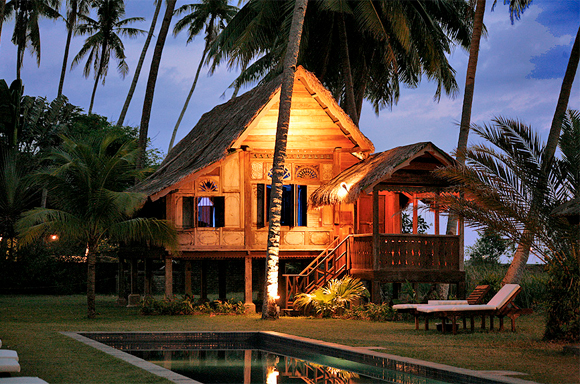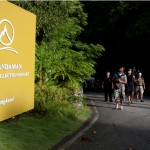Lush, Luxe Langkawi
Untamed natural beauty? Check. Seaside luxury? Check again. In fact, the only thing you’re not likely to find on Langkawi, a holiday island located off peninsular Malaysia’s northwest coast, is time enough to explore it all
Assigned Global Geopark status by UNESCO in 2007 for its “outstanding geological landscape,” Langkawi–the name refers both to the main holiday island where we’re based and to the little archipelago that it anchors–has more than its share of natural marvels. As we cruise past towering limestone outcroppings en route to the mangroves, Aidi informs us that Langkawi is home to the most complete Paleozoic sedimentary sequence in Malaysia, meaning that its rock formations and fossil beds lay bare half a billion years’ worth of the Earth’s history.
Two of the geopark’s three key conservation areas, conveniently, are on Langkawi’s main island: Mount Mat Cincang, whose ancient for-ests give on to scenic waterfalls and beautiful beaches; and Kilim Park, where we are now, a 24-square-kilometer preserve of limestone hills and coastal waters watched over by slowly circling Brahminy kites, Langkawi’s official bird.
The third area is on the neighboring island of Dayang Bunting and harbors some of the world’s finest marble formations. These surround Tasik Dayang Bunting (“Lake of the Pregnant Maiden”), a freshwater expanse said to enhance the fertility of those who dive in.
Like a good maid of honor, I threw Betsy into the lake the day before, so she’s understandably wary of getting dumped in the mud by her big sister on today’s mangrove tour. When we set off earlier this morning at a relatively cool eight a.m., she secured a seat in the middle of the boat, and hasn’t budged since.
Despite her attachment to our knockout beachfront abode and the Four Seasons’ addictive lobster mac and cheese, Betsy is as eager as I am to check in to our next digs. Opened in 1993, The Datai has a cultlike following, most of whom return regularly to this northwest tip of Langkawi. It’s easy to see why. Crouched on a hillside between centuries-old virgin rain forest and a cove edged by a long crescent of white sand, the resort puts you quite literally on nature’s doorstep, without sacrificing an iota of comfort.
At the main building, a fortress-like structure of stone and indigenous woods that somehow manages to meld with the wild landscape, we’re met by The Datai’s Scottish general manager, Eleanor Hardy. She leads us through the absurdly lush property to one of 40 elegant guest villas. We enter a room filled with sunlight streaming over raw silk and polished mahogany. Floor-to-ceiling windows face trees filled with frisky macaques.
Even before Hardy has a chance to caution us not to leave anything on the balcony lest the animals steal it, we see the branches outside shake as one of our furry neighbors swings past. She also tells us to keep an eye out for a baby dusky leaf monkey that was born a month earlier. His fur is still golden. Seeing him becomes our mission as we settle in and attune our ears to a symphony of birdcalls–the screech of white-bellied eagles, the kek-kek-kek of collared kingfishers, the eerie whoops of hornbills.
We rise with the sun to meet Irshad Mobarak, clad in jungle camouflage, Irshad, who runs an outfit called JungleWalla Tours, regularly leads complimentary bird-watching treks for guests of The Datai. When I grouse about having to get up so early, he explains that eight in the morning is already midday in the rain forest. Before I can seriously consider sneaking off back to bed, guttural hoots reverberate around me.
Irshad is calling out to the forest in one breath, and explaining to us in the next that the April-June dry season is also the beginning of the flowering season, when seed-bearing fruits are at their ripest. When the rains finally come, he says, the seeds will germinate and a new cycle of life “at least as old as the Cretaceous period” will begin.
My eyes flit from an Asian fairy bluebird to a racket-tailed drongo and a sinuous egret, all seemingly lured by our guide’s expert calls. As we go deeper into the jungle, Irshad points first to an Indian ironwood tree and then upward to where four long-tailed macaques are lounging among the branches.
These monkeys, he warns, can be “rather confrontational, but if you’re ever lost in the forest, follow them and eat what they eat.” Betsy and I vow to stick close to him.
Later, we here a cacophony overhead that turns out to be a great hornbill chasing off a drongo–a relatively easy task, I imagine, for a bird armed with a huge scythe-like beak. We watch as the hornbill alights at his nest, regurgitates his family’s next meal, and then swooshes away on enormous wings. I’m awed by the spectacle, but already our guide is surging ahead through the undergrowth toward the shrill chirping of what he calls “the most beautiful bird on Langkawi.”
Irshad calls back to her with a rhythmic whistle that sounds almost flirtatious to my untrained ears. Soon enough, we see a brilliant orange-breasted trogon perched on a high branch. “You’re lucky,” Irshad says. “This is the bird that everyone dreams of seeing here.” And with a final glance aloft, we follow him back toward the beckoning beach.
That night, Betsy and I make one last set of tracks through the trees to dine under the thatched roof of The Datai’s kampong-inspired Gulai House, which sits on stilts above the sand at the forest’s edge. As plates piled high with fluffy pakoras, steamed snapper in lemongrass and garlic, and daging lada hitam (wok-fried beef dressed with black pepper and kaffir lime) arrive at our seaside table, we hear monkeys shake the branches overhead. They clearly know what they’re missing.
The last stop on our Langkawi itinerary occupies a former coconut plantation inland from Cenang Beach, on the island’s southwest coast. Back home, Betsy rescues stray dogs in her spare time and has written a book about responsible pet ownership. So I know that she will adore Bon Ton Resort.

Bon Ton Resort
Its owner, an Australian expat named Narelle McMurtrie, is a committed animal lover, and provides refuge to stray cats and dogs (of which there seem to be plenty here) on her verdant grounds. The adjacent Langkawi Animal Shelter and Sanctuary Foundation (LASSie), which she co-founded, is supported by direct guest contributions and a percentage of hotel profits.
There’s plenty else to love about Bon Ton, too, like its rustic 19th-century Malay houses that serve as guest quarters, all appointed with four-poster beds, antique bathtubs, and time-polished teakwood floors. Then there is the resort’s highly regarded Malay and Chinese cuisine, inspired by recipes dating back to the heyday of the spice trade.
We indulge on arrival by digging into a scrumptious Nyonya Platter, served on a banana leaf with freshly caught prawns, fish in tamarind sauce, coconut lamb, jackfruit curry, and mango-cashew rice. Betsy only manages a few bites, though: she’s too busy chatting with McMurtrie and stroking the menagerie of cats that gravitates to our table in hope of treats.
After lunch, McMurtrie leads us, four-legged flock in tow, next door to Temple Tree, her other unique collection of heritage houses. There are nine of these, each relocated from Malaysia’s ethnically diverse regions.
I settle us into the Chinese House, once the home of a Johor State merchant, before taking a seat on its wraparound veranda to watch the sun sink beyond tall swaying grass into the Andaman Sea. Betsy, meanwhile, heads off to inspect the shelter.
She returns with the energy of a puppy, words leaping off her tongue about how well cared for the animals are, about the “amazing” vet who looks after not just these “happy, healthy dogs and cats” but also others around the island who might not otherwise receive medical attention. I fall asleep listening to her talk about her new canine friends John-John, Queenie, Snowy, and Rusty through the house’s vintage wooden slats.
Hanging out with dogs does not require the early start of bird watching, so at breakfast we linger over Langkawi’s frothiest lattes and fruit platters laden with pineapple, melons, and mangos. Fortified, I follow Betsy across the grounds to the LASSie shelter, where my pooch-loving sister has signed us up for a morning of dog walking. And not just a pair of dogs, mind you, but an entire pack (the next morning, we’re holding 20 leashes between us). “This is better than hiring a personal trainer or slaving on the treadmill,” Betsy shouts, encouraging me to press ahead despite the sweat trickling down my back.

Though the dogs are walked daily by local volunteers and resort staff, Betsy says she can tell the animals appreciate these unscheduled outings. Later, over a few well-earned rounds of Bon Ton’s cooling lemon-mint slushies, she adds, “Getting out of my own head and helping these loving creatures is ultimately so much more relaxing than baking in the sun reading a glossy magazine filled with things you want to buy or be. Plus, the food is so good here, I feel like I can eat whatever I want and burn it off while helping out.” That’s my sister for you. I suspect she’d pack a puppy in her carry-on if the flight home wasn’t so long.
Before leaving the island we take one last look at its natural assets, this time from the perspective of the 125-meter-long Langkawi Sky Bridge atop Mount Mat Cincang, Langkawi’s second-highest peak. To get to the summit, we ride the cable car from Burau Bay, just north of Bon Ton, above a dense forest canopy, which gives us a bird’s-eye view of the treetops.
The bridge itself is suspended between Mount Mat Cincang and a neighboring summit, some 700 meters above sea level. It makes for an exhilarating walk. But even as we admire this feat of engineering, our eyes silently agree that no man-made marvel can best the scenery stretching out before us–the teeming forest, the azure sea, and the infinite horizon beyond.
Malaysia Travel: Lush, Luxe Langkawi
Monday 1 August 2011
By Cynthia Rosenfeld
Photographs by Lauryn Ishak
 Previous Post
Previous Post Next Post
Next Post







